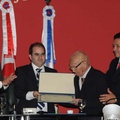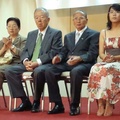Statistical data for 2007 reveal that more than 300,000 Brazilians are currently working in Japan, exceeding the nearly 250,000 Japanese that have arrived here since the beginning of Japanese immigration to Brazil one hundred years ago.
According to that same data, approximately 30% of those will probably never return to Brazil – individuals who had originally left with the goal to “make money and return” to their native land.
Of interest: that same situation had already been experienced by their ancestors who, pressured by adverse conditions in a country desperate to become modernized like the capitalist countries of the West, found promise in overseas possibilities that were duly reinforced by propaganda from expanding businesses.
Surely, most emigrants who leave their native land in search of better socioeconomic conditions carry in their soul the hope of the return. Even without knowing when that will be possible, or even if it will be at all possible, it’s a comfort that helps to alleviate the pain of separation.
At this stage, I’d like to discuss the “return” theme, or rather, the myth of the return, which always recurs at different moments during human migrations, and that is also noticeable among both the Japanese immigrants in Brazil and the Nikkei in Japan. I’d also like to mention the historical unfolding of this feeling at certain periods of the Japanese-Brazilian community’s history.
In 1908, the arrival of Japanese immigrants in Brazil
In all probability, many Japanese while boarding ships leaving for Brazil had no idea of what it meant to go around the world to work in coffee plantations. Or rather, they had the wrong idea: they believed that after approximately five years of hard labor they would accumulate enough savings to return to Japan.
That belief can be found in the histories of most Japanese immigrants in the state of São Paulo. As they came across a completely different reality, they were forced to admit that they would have to extend their stay in the country – though without abandoning their dream. This perspective will profoundly influence both the relations that these nuclei of settlers would establish with their surroundings and their own internal organization. That was a temporary measure, a test of fire to guarantee a promising future in Japan.
We can say that for most of the families the end of World War II marks the abandonment of that dream, of that stance; in other words, the abandonment of the preservation of their culture and social organization because their eyes were turned toward Japan.
Within the context of the post-war period, one should highlight the Japanese government’s adopted policies, which had begun in the mid-1920s, applicable to those wishing to go abroad. The government not only encouraged emigration to Brazil (even paying for travel expenses), but also strengthened the actions of the “colonizing” businesses, offering conditions for their permanent stay on Brazilian soil and guaranteeing a strong relationship with agencies in their native country.
Within that structure, we should give prominence to BRATAC (Brasil Takushoku Kumiai) – Settling Society of Brazil Ltd., created in São Paulo in 1929, and responsible for the organization and administration of the colonies of Bastos, Tietê (today’s Pereira Barreto), Alianças and Três Barras (today’s Assai, in the north of the state of Paraná), encompassing a total area of 439,092 acres.
Additionally, other business initiatives in the Brazilian North brought new Japanese immigrants thanks to land concession agreements granted by the governments of Pará (3.2 million acres) and Amazonas (2.4 million acres).
One should note that, with the passing of the years, this migratory movement of Japanese immigrant settlers in coffee plantations in São Paulo gained strategic importance for both the Japanese government and that country’s entrepreneurs.
Nonetheless, most of them never abandoned the dream of the return. They worked nonstop, suffering all sorts of hardships in order to go back as winners and proud subjects of the Japanese Empire. It was a dream that few were able to make come true.
In the 1980s, crucial changes
The trajectory of the Japanese immigrants followed its course and, in the 1980s, there was a certain “unanimity” in the air among Japanese-Brazilian community leaders in regard to the “total assimilation” of Japanese descendants. The number of interethnic marriages pointed toward this inexorable trend.
Those who were more conservative looked with a certain melancholy to the young descendants who abandoned the learning of the Japanese language. “Japanese culture brought by us, immigrants, and preserved with care, in a few years will be forgotten by the next generation,” they complained.
However, a new phenomenon gained intensity at the end of the 1980s – the dekasegi migratory movement, which had the same motivations as the one that had brought our ancestors to Brazil (to work, to save, and to return). Initially, it was composed by the Issei (those born in Japan), followed by the Nisei. From the 1990s on, the Japanese legislation opened up opportunities for those of mixed ethnicity and spouses without Japanese ancestry.
Economic reasons – such as unemployment or debts to liquidate – were the main impetus for the trip to Japan and for accepting jobs on the factory floor. Also, the chance to amass savings so as to, finally, achieve professional independence.
Would those have been the only justifications – let’s say, purely economic – to leave everything behind and to travel to the other side of the world? Certainly, economic reasons would have been incontestable when facing family and society and, without a doubt, they exerted a role of great importance, but I believe that it’s important to highlight other points as well.
First item: the opportunity to finally get to know the land of their ancestors. Here, within the context of this migratory movement, the “Japan” chapter has a special ingredient when it comes to the desire to “return” and to get to know the land of one’s parents and grandparents.
This motivating component was probably understood by the Japanese authorities who, without openly admitting it, opted to open the doors to workers who were “blood of my blood” and who knew “Japanese culture” – and to put a stop to illegal workers from East Asia and other Asian countries. With the passing of time, it became evident that these similarities would not completely solve the problems of cultural shock for either the Brazilian or the Japanese side.
Going back to the first item: especially during the first decade, joining the ranks of the dekasegi migratory movement were those who always nourished the dream to go to Japan, but who didn’t have the financial means to do so. Those were people outside official statistics: they worked for a certain time and, afterwards, made a point of spending all their savings traveling around the country.
For many, that represented the opportunity to finally get rid of – or to distance themselves from – family or marriage problems. The need to find better moneymaking conditions was a highly convincing excuse that would take care of some of those issues.
Nowadays this doesn’t happen as often, but it’s known that during the first few years the tragedies experienced by abandoned families in Brazil were amply disseminated by the media. For instance, the husband who went to Japan leaving behind his wife and children, and who disappeared after a few months, to the despair of all. In some cases, it was discovered that at a later date the “runaway” had formed another family in Japan.
Well known in Brazilian society for their discreet behavior (sometimes, exaggeratedly so!), many of those Japanese descendants saw the possibility to change their lives. For many men and women, regardless of age, it was an opportunity to rid themselves of social ties and to lead a new lifestyle in Japan.
Throughout the daily routine, life with the Japanese
“Nothing will be as before,” Elis Regina used to sing. Probably many among the dekasegi didn’t analyze carefully what would mean to their lives their going to work in a different country with the idea of “coming back one day.” The truth is that to live on the other side of the world, to live the daily routine of the Japanese, and to experience a different culture has led to profound changes in the lives of each one of them.
Individual experiences notwithstanding, for the majority of those that means the demystification of the “Japan concept” they had learned from their ancestors while “bringing up to date” the current Japan – a capitalist country like any other, and that he, though having Japanese ancestry, has value only as part of the productive working force. A Japan quite different from that image transmitted by our parents and grandparents throughout their lives in Brazil. Many dekasegi were reluctant to accept that cruel reality. Some labeled the Japanese as cold. Some Japanese labeled the Nikkei as hicks.
It’s curious that these Brazilians in Japan, experiencing adaptation issues just like their ancestors during their first years in Brazil, make use of the same stratagems. For a number of years, it can be observed the growth and strengthening of Brazilian “colonies” in an attempt to provide shelter and protection from an environment they find “hostile.”
Here it’s replayed, like in other countries with a large number of Brazilian workers, the same behavior of giving great value to “Brazilian things,” as if they wouldn’t be able to survive without Brazilian products such as rice and beans, feijoada, steaks, pastéis, maize flower, cassava, etc. For their psycho-sociocultural survival they begin to exacerbate minimal things from their native land that never before had been given any importance. We can mention, for instance, taking part in Carnival parades. We know that in Brazil few descendants of Japanese parade in the streets with the samba schools. The same happens with the practice of capoeira, música sertaneja (Brazilian country music), etc.
We can’t forget other aspects that are currently the focus of their biggest concerns: the high number of out-of-school children and youth in a community that in Brazil was well known for its high schooling percentage. Here we can ask a question: could it be that the parents, disenchanted with their university diploma (in other words, despite the diploma they became dekasegi!), reached the conclusion that their children don’t need to “waste” time at school? Or could it be a matter of lacking money (or the pain of spending their precious money, the reason for their move to Japan)? Or a lack of planning for the future – not knowing whether to stay in the country or to return to Brazil?
Whether it’s the fault of the parents or the authorities, the fact is that the children of Brazilians are responsible for one of the highest index of criminal cases among foreign communities – in stark contrast to their image in Brazil, marked by the impeccable behavior of both youths and adults.
So, what could have happened (or is happening) with these dekasegi?
Upon their return to Brazil, nothing will be as before
In Brazil, the dekasegi migratory movement has led to changes in the Nikkei community, creating unusual and interesting situations.
Updates about Japanese culture occur as a result of news brought by the dekasegi to Brazil, be it in terms of customs, sports, language, behavior, food, and other aspects.
Statistics on the Japanese population in Brazil reveal that most of them arrived before World War II (approximately 188,000), bringing with them the culture of the Meiji Period (1888-1912), which remained frozen throughout the years. By relating the Japanese immigrants to that period, depending on how it is done, one can imply cultural “backwardness” or one may be highlighting the qualities of a group that has preserved values that are genuinely Japanese without having been “contaminated” by “modernizing” attitudes (especially after Japan’s WWII defeat).
Within this “revitalization” promoted by the dekasegi, we can mention sumo, a sport practiced by the pioneering generation in the old colonies. The spreading out that followed urbanization led to a reduction in the number of practitioners and admirers of this sport. In Japan, many of those Brazilians learned to appreciate sumo (which remains a national sport) and upon their return to Brazil they have continued to follow it on television.
After living for several years in Japan, these dekasegi have also reinforced some elements of cultural globalization: fashion from Japanese culture, the anime and manga fevers, taiko, and other traditional Japanese cultural elements.
If in the 1980s they were predicting an increase in the number of interethnic marriages, the dekasegi migratory movement has led to an increase in marriages among Nikkei. And what’s most interesting about this fact is that these unions have resulted in interchanges among Japanese Brazilian communities from different areas of the country: it’s common to find marriages between Nikkei from different states or cities of the federacy. For instance, someone from São Paulo may get married to someone from the Pará capital of Belém, situated nearly 1,850 miles to the north! It’s a phenomenon that would have been highly unlikely had they continued to live in Brazil.
Something else that can be seen is that the return of those Nikkei to Brazil has not necessarily meant a substantial growth among or strengthening of Japanese Brazilian social entities, as many leaders believed at the beginning of the migratory movement. To the contrary, what can be perceived is that many dekasegi have stopped taking part in these social activities.
Could it be that they still haven’t been able to get rid of a certain type of “prejudice” so evident in the 1980s? In other words, a schism that profoundly marked the first years of the migratory movement, both in Brazil and in Japan, which was a result of the ethnic ties on both sides. At that time, there was the idea of a “people trade” consisting of those willing to perform jobs despised by Japanese workers.
In Japan, they accused the “emigrants” of having abandoned the country at a time when it most needed their labor; that they had gone overseas in search of “money.” A serious accusation, but one lacking any historical basis. Thus, the emigrants would have “deserted,” abandoning the country to its own luck. Now, their children returned to Japan “defeated” and willing to work in activities of little “prestige.” In fact, during the first years of the migrations, some dekasegi admitted to having been rejected by their Japanese relatives. Maybe because they were worried about what their neighbors would think, or they were concerned with potential requests for assistance or charges related to past deeds!
Obviously, here in Brazil that mistake wasn’t made in regard to the perception of those workers. But the fact that there was a family member who, in difficulties, subjected themselves to “heavy, dirty, dangerous” work in Japan did lead to an undeniable feeling of rejection. That said, later, with the financial “success” of the experience, the prejudices were abandoned – also due to the fact that having family members working in Japan became something widespread among Japanese Brazilians!
So, allow me another question: could it be that they don’t feel well-received by an organization that doesn’t consider the difficulties faced by the dekasegi a community problem? In other words, by the organization that considers the dekasegi issue a family or individual problem?
The fact is that to date there are few Japanese Brazilian organizations that have tackled the dekasegi issue as one of their priorities and as a social problem to be resolved by the whole community. I believe that if there were a joint effort, such as what took place during the pioneering years of Japanese immigration, an ideal solution would be found for many of those problems.
So, these are some of the matters I wished to point out regarding the dekasegi and the myth of the return involving both Brazil and Japan. They encompass the issue of identity for Japanese Brazilians and, no doubt, are alluring raw material for dedicated scholars.
* Célia Abe Oi was a panelist in a presentation titled “Dynamic life of migrants between Brazil and Japan—Perspective on Brazil” at a Discover Nikkei Symposium—“100 Years of Japanese Immigration: The Multiple Identities of the Nikkei Community” in Sao Paulo on September 20, 2008.
© 2008 Célia Abe Oi






